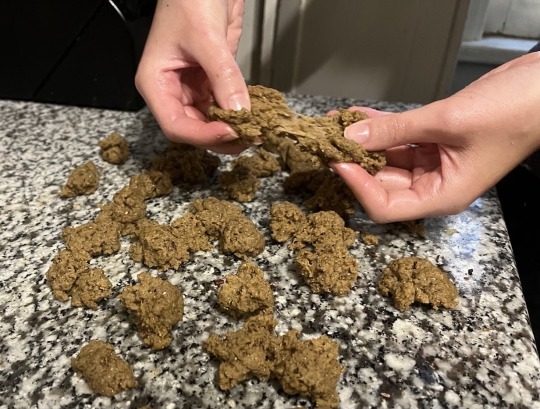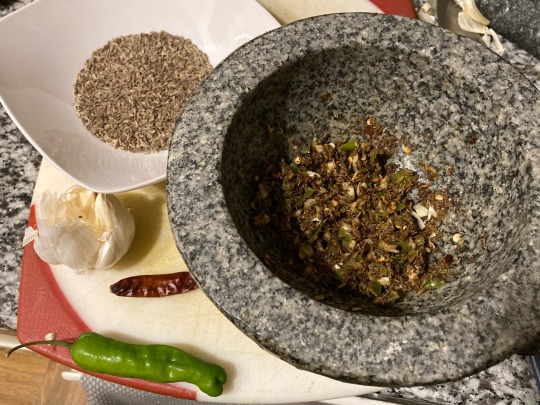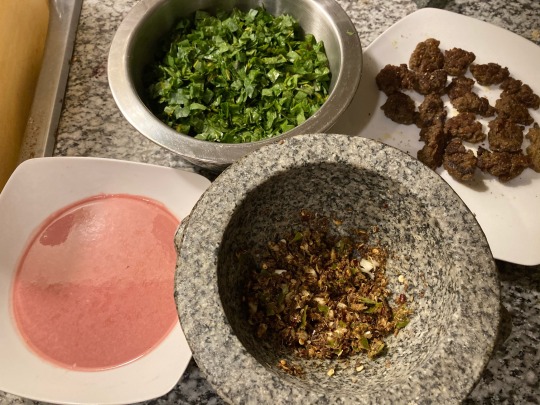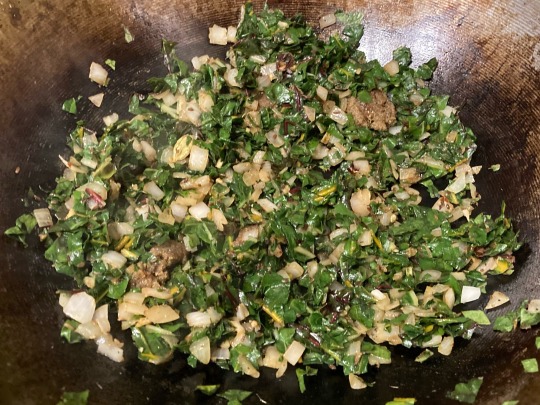#sumagiyya
Text

Palestinian Lamb Stew with Sumac, Chard, and Chickpeas
#food#recipe#dinner#sumagiyya#stew#lamb#onions#chickpea#swiss chard#sumac#dill#garlic#serrano#peppers#tahini#cinnamon#palestinian
99 notes
·
View notes
Text

[ID: A greyish brown stew presented alongside flatbread, red pepper paste, green peppers, and carrot sticks. End ID]
سماقية / Summagiyya (Gazan stew with chard, chickpea, sumac, and 'lamb')
Summagiyya (سُمَّاقِيَّة; also translitered "sumagiyya", "sumaghiyyeh" or "sumaqiyya") is one of the signature dishes of the Gaza strip, in particular Gaza City. It consists of lamb, chard, and chickpeas in a sumac-infused broth; savor and zest is added by a dagga of dill seeds, garlic, and peppers, and nutty depth by a generous drizzle of red tahina. The resulting stew is thick, earthy, and slodgily grey (due to the green chard and red sumac)—it also has the characteristic sourness of much Gazan cuisine.
Summagiyya is most often prepared during holidays, especially Eid al-Fitr; it's an excellent make-ahead dish for these occasions, since it's even better once its flavors have had time to meld and mellow overnight. It is served cold alongside fresh vegetables, and eaten by using flatbread to scoop up each bite. This recipe provides a spiced seitan recipe to replace the lamb, but you may also use any lamb or beef substitute of your choice.
Today, summagiyya is often prepared with Israeli white tahina, as decades of punitive import laws, taxes, and restrictions have enforced Palestine's status as a consumer, rather than an producer, of food products. Israeli tariffs on, and confiscations of, Palestinian goods have forced those tahina factories that survived to import sesame seeds rather than using locally grown crops, even as they export the best of their product to Israel. The dubbing of foods such as tahina and hummus as culturally "Israeli" cuisine works to hide this exploitative relationship, and cement an Israeli national identity through the subsuming and erasure of Palestinian existence. It is for this reason that Emad Moussa writes that Palestinian cuisine has a role in "protecting against a people's very extinction."
Medical Aid for Palestinians (MAP) has put out an urgent call for donations to provide medical supplies to Palestinian hospitals when supply lines reopen. Also contact your representatives in the USA, UK, and Canada.
Ingredients:
For the soup:
500g (2 large bunches) chard (شلق), diced
80g Levantine sumac berries (Rhus coriaria)
1/2 cup soaked and boiled chickpeas, mostly cooked (40g dry / scant 1/4 cup)
1/4 cup red tahina
1/2 cup (60g) all-purpose flour
1 large yellow onion
1/4 cup olive oil
1 tsp kosher salt
2 cardamom pods (optional)
2 allspice berries (optional)
More olive oil, to fry
Sumac berries can be found in the spice section of a halal grocery store. If you're unable to locate whole berries, pre-ground will do.
For the dagga:
1 1/2 Tbsp dill seeds
5 cloves garlic
1/2 green cubanelle pepper
2-3 dried red chilis (optional)
1/2 tsp black pepper
1/4 tsp cumin
Dill seeds may be found at a halal, south Asian, or speciality European grocery store. They are commonly used in Indian food and as a pickling spice. At a south Asian grocery store they may be labelled soyo, suva, shepu, or savaa.
For the lamb:
1 cup (120g) vital wheat gluten, aka gluten flour
1/2 Tbsp ground sumac
1/2 tsp ground caraway
1 tsp onion powder
1 tsp Palestinian 7-spice
1/2 tsp garlic powder
1/2 tsp sea salt
1/2 tsp ground black pepper
1/2 tsp ground cumin
1/2 tsp ground aniseed
1/2 tsp turnermic
1 tbsp olive oil
1/2 tsp soy sauce
1 tsp miso paste
2 cloves garlic, grated
2 tsp pomegranate molasses
1 Tbsp white or red tahina
About 1/2 cup vegetarian 'beef' stock from concentrate, or vegetable stock
Pomegranate molasses is simply pomegranate juice that has been reduced to a thick consistency. It may be found in the sauces section of a halal grocery store.
Instructions:
For the soup:
1. Soak dried chickpeas in cool water overnight, or in just-boiled water for an hour. Drain and re-cover with water, and boil for 30-45 minutes, until almost fully cooked. Drain and set aside.
2. Simmer sumac seeds in enough water to cover by a couple inches for about an hour, until the water is dark red. Blend the seeds and water together, then strain the mixture through a cheesecloth.
If you're using ground sumac, skip the blending step. Use a cheesecloth or very fine metal sieve (such as one intended for brewing tea) to remove the ground spice from the water.
3. Whisk the flour into the sumac-infused water.
For the lamb:
1. Combine all dry ingredients in a large mixing bowl. Add wet ingredients other than stock and stir briefly. Add enough stock to produce a soft, smooth dough.
2. Knead by hand on a clean surface, or put in a stand mixer with paddle attachment on medium-low, for about 5 minutes. You should see stringy strands begin to form in the dough.
3. Allow to rest, covered, for 5-10 minutes to encourage gluten formation. Knead for another 3 minutes. Do not over-knead.
4. Tear the dough into bite-sized pieces.

Stringy seitan being pulled apart into pieces.
You may also shape the dough into a slab and cube it with a sharp knife—the lamb or beef used in summagiyya is usually cubed—but I prefer the texture of torn seitan to sliced.
5. Steam the seitan pieces for 10 minutes in a bamboo steamer or using a metal steamer basket. Place the bamboo steamer in the bottom of a wok and cover its base by about 1/2" (1 cm), then raise the heat to boil the water; lower the heat to keep the water at a simmer. If using a steamer basket, place it over the opening of a pot containing a couple inches of water and bring it to a simmer. Start the timer when the water begins simmering.
6. Heat olive oil on medium-high and sear the steamed seitan pieces, turning as necessary, until deeply browned on all sides. Set aside.

Fried seitan pieces.
You can save a step here by searing the raw seitan, then returning it to the pot after you've fried the onions to simmer it rather than steaming. I found that this produced a mushier texture.
For the dagga (دقة):
1. Grind cumin and black pepper thoroughly in a mortar and pestle, then add dried red pepper and dill seed and crush coarsely. Add green sweet pepper and garlic and pound until a coarse mixture forms.

Dill seeds, green sweet pepper, garlic, and dried red chili on a cutting board, alongside dagga in a large granite mortar.
You may also use a spice mill or food processor.
To assemble:
1. Chop the onion. Wash the chard and slice it thinly in one direction; turn it ninety degrees and slice thinly again.

Diced chard, fried seitan, dagga, and sumac-infused water with flour.
2. In a large pot, heat a couple tablespoons of olive oil on medium. Fry chopped onion, cardamom pods, and allspice berries for a minute until fragrant. Add half of the dagga and fry until fragrant.
3. Add chard and fry, mixing often, until wilted.

Wilted chard in a wok.
4. Add sumac mixture, chickpeas, and water to cover. Bring to a boil, then lower heat to a simmer. If you didn't steam your seitan earlier, add it now.
5. Continue to stir and simmer until the stew is thick, homogenous, and greyish-brown, about 15 minutes.

Simmered stew.
6. Add the remainder of the garlic mixture, the red tahina, a pinch of ground cumin, the 1/4 cup olive oil, and salt to taste. Return the steamed and seared seitan to the pot and mix.
Serve cool with flatbread, sweet green peppers, bitter green and black olives, carrots, leafy greens, and/or pickles.
#vegetarian recipes#vegan recipe#vegan cooking#Palestinian#Gazan#chickpeas#lamb#seitan#chard#dill seeds#pomegranate molasses
475 notes
·
View notes
Text
"As I read Nael’s texts, the memories came flooding back. Of Um Hani cooking in her bright, breezy kitchen wearing the traditional white hijab and light blue jalabiya. Of the birthmark on her face and her soft olive skin. Of her husky voice and the gentle laugh that masked the fierce and determined woman underneath."
7 notes
·
View notes
Text
A Cuisine Under Siege
I couldn’t rescue my aunt in Gaza, but I can keep her recipes alive.
Though I’ve lived abroad most of my life, Gaza is where I call home. It's where my parents were born and raised and where I spent summers as a child. Whenever we’d return, we’d be welcomed back by our large extended family. First among them was my aunt An’am Dalloul, whom we called Khalto Um Hani: “mother of Hani,” her eldest child and my cousin. She’d always arrive bearing a bowl of sumagiyya, Gaza City’s signature meat stew with chard, sumac, and chickpeas—and my father's favorite meal.
Um Hani, along with my cousins Hoda, Wafaa, and Hani, were killed in an Israeli airstrike in their residential Gaza City neighborhood in November 2023.
In an instant, the household perished, my cousin Nael later told me. Only a skeleton of the building was left. He recounted the horrific scene over WhatsApp—how he gathered their remains in his arms and buried them in a mass grave under heavy Israeli bombardment, how he failed to retrieve the corpse of one of his sisters, and how his brother bled to death before paramedics could reach him. Nael, like 90 percent of Gazans at the time of writing, is displaced, fleeing with his children from one city to the next in search of shelter, food, and some semblance of safety. He has been surviving on canned beans for more than three months.
Nael’s news shook me to my core. I couldn’t sleep. I couldn't eat. I was overwhelmed with a profound sense of helplessness and despair. Was it only a matter of time before the rest of my family in Gaza would perish?
As I read Nael’s texts, the memories came flooding back. Of Um Hani cooking in her bright, breezy kitchen wearing the traditional white hijab and light blue jalabiya. Of the birthmark on her face and her soft olive skin. Of her husky voice and the gentle laugh that masked the fierce and determined woman underneath.
Um Hani was an anchor to me, a link to the paternal grandmother I never met and to a city I often felt estranged from. She was a repository of memories, a key to the fragmented world to which I belonged as a Palestinian. She taught me to make the near-forgotten dishes my grandmother loved, the ones my father grew up eating such as adas wi batata (lentils and potatoes cooked in a clay pot with lemon and fried garlic) and samak il-armala (“widow’s fish,” or fried eggplants with chiles and ribbons of fresh basil). But as fate would have it, she never got the chance to show me how to make sumagiyya—her specialty, brimming with lamb and spiced with dill seeds and cumin.
[...]
I live in the United States now, and I’ve cooked sumagiyya more times than I can count—even if it never tastes quite like Um Hani’s. One occasion stands out. It was May 2021, and Gaza City was being pummeled in what was the fourth major assault by Israel on Gaza in 14 years. The attack coincided with Eid, and as I watched on my screen in Clarksville, Maryland horrific images of air raids and grief-stricken mothers, I suddenly felt the urge to make a pot of sumagiyya.Serving it to my family and friends that night, despite the unfolding tragedy, was unexpectedly liberating and affirming.
Last month, I again found myself in tears chopping onions and chard for sumagiyya, but this time I was making it to honor Um Hani’s memory. Like in 2021, I couldn’t look away from the news: The park where I used to take my son for evening strolls, the beach promenade where I drank sage tea with my mother, the university where I gave guest lectures—they were all unrecognizable piles of overturned dirt and warped wire.
[...]
Lately, I’ve been thinking about what I would go back to, and what I would find, if I returned to Gaza. Most of the landmarks have been destroyed. Gone too are many of the people I cherished. But with Ramadan fast approaching, and with no end in sight to the bombardment, it feels like I am the torchbearer now, the family’s keeper of treasured recipes. Like Um Hani, I will cook and I will teach, connecting the next generation of Palestinians to our homeland.
2 notes
·
View notes
Note
That’s interesting I might actually take a look at that book. What your favorite recipe so far?
In Zaitoun?
She has a recipe for Hummus with Spiced Lamb which was really appealing to me.
Other recipes that stood out were:
-Seared halloumi with orange, dates, and pomegranates
-Donyana salad
-Red lentil and squash soup with za’atar croutons
-Eggplant and feta kefte
-Za’atar roast salmon with garlicky bean mash
-Roast chicken with sumac and red onions (mussakhan)
-Layered chicken and flatbread feast with yogurt and chickpeas (fatteh djaj)
-Gazan beef, chickpeas, and Swiss chard (sumagiyya)
-Knafeh (described as the “glorious love child of baklava and cheesecake)
0 notes